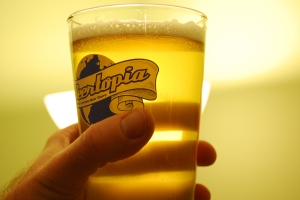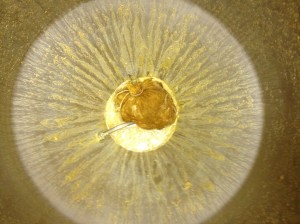Since it was last discussed here, my stance on this “style” has softened a bit. I have found it useful to view it as more of a Pilsner which used the wrong hops and was fermented with an ale yeast. Continue reading
Tag Archives: IPA
brew day: Inevitable Conclusion Double IPA
Oh no, my hops are out.
(video is NSFW, and not likely to make sense if you’ve never rolled a D20) Continue reading
I kegged an IPA today, oh boy
It was a lucky ale with EXP 5256; and though the beer was rather flat, I still had a draft. I took this photograph.
brew day: Get The Acorn
It will probably be the last brew day of October, and it may well be the last brew day under the open sky before the looming winter of 2013/14 ushers operations into the garage and kitchen. It will be a day to play hooky and eat lustily of the tacos of bachelorhood, even if only for an afternoon, and over the sink so I don’t have to wash dishes later.
It will be a west coast IPA with West Coast IPA, riffing on the recipe for Russian River Blind Pig in Mitch Steele’s IPA. It will have some well-loved old friends – Rahr 2-row, Amarillo, Simcoe – and some new blood too: Polaris for the bittering power, EXP 5256 standing in for CTZ and Cascade where called for in the Blind Pig bill. Continue reading
GABF impressions
Here are my notes – jetlagged and sleep-deprived though they be – filtered through three straight days (four, if you count setup and the Brewers’ Gathering on Wednesday) of the Great American Beer Festival. Continue reading
I’m drinking hydrometer samples
I’m just about to sod off to the GABF for the rest of the week (times change, citizens) but before I go, a quick update on the last batch: Continue reading
German IPA, Polaris, 1217, process, self-righteousness – must be an October brew day
There I was, citizens: I was enjoying the last gasps of Minnesota summer while brewing outside, I was drinking something from Maine Brewing Co., I was trying out some new hops and new yeast, I was smelling the roast happening at the coffee shop downwind, I was gristing some malt and heating some water and ruminating on a recent conversation with friends. Continue reading
First Gold IPA
Or, Need a Bigger Boat Bitter.
prep day: Quotidian Pale Ale

Back in my day, when we had a gold-to-amber colored hoppy ale that was about 4.5% abv, we didn’t call it Session IPA. We called it “pale ale.” It was bitter but balanced, reasonable about its alcohol content, and it smelled like grapefruit and pine trees and cat piss … and we liked it that way. Continue reading
nothing new under the sun
One of the great things about a fiber-rich diet is that it affords daddy some quality reading time in his special office, and this morning some muesli induced me to finally start digging in to Mitch Steele’s IPA (that’s an acronym for something, but I’m not far enough along in the book) and came across this nugget regarding (probable) brewing practices for the nascent style in the 18th century:
Hops were added during the boil and were often only allowed to boil for 30 minutes before being pulled out and replaced with another charge. It is cited in many brewing texts of the period that brewers believed that boiling hops for more than 30 minutes extracted rough and harsh flavors and bitterness.
Kind of a philosophical antecedent to the whole late-addition and hopbursting approach – not directly analogous and probably with not quite the same results in the kettle, but still predating the 21st century craft brewing “hoppy not bitter” mantra by a good 250 years. Nothing new under the sun.
Also:
Occasionally hair sieves were used to strain the hops from the wort.
Maybe there’s a market for follicle-based hop-separation technology in modern home- and craft brewing? Somebody try that out, let me know how it goes.



